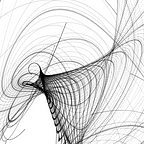HashCrash ArtBlocks Release
What is HashCrash?
HashCrash is a new generative piece by Beervangeer, inspired on the book SnowCrash by Neal Stephenson. Stephenson is a visionary writer that wrote this classic book in the nineties about what he called the MetaVerse. Something we are now trying to build from within the NFT culture and of course Zuckerberg also trying to take over the concept of the MetaVerse.
Not only did Stephenson coined the term MetaVerse, he also described a digital item format called HyperCards, tradable items in the MetaVerse. Very similar as how we are using NFT’s nowadays.
One of these HyperCards in his book was called SnowCrash, a digital visual message build from white noise. Once someone witnesses this noise in action after opening up the HyperCard, the viewer would go into a state of trance. The noise transmits a virus through the optic nerve, taking over the nervous system of the viewer. In the story there is an evil villain (a media magnate named L. Bob Rife) that developed SnowCrash to turn people in mind controlled zombies, losing their ability to speak their own language. The story turns into a Tower of Babel variant (inverted), where people are only able to talk in tongs.
HashCrash plays into this concept of a digital encoded message, acting like a drug or virus. Is it possible to create NFT’s that evoke certain emotions or reactions in the nervous system? It can not be denied that NFT’s already have great impact on our behavior and influences our emotional responses (think of addictive behavior in collecting NFT’s, the price rushes that can give euphoria or panic etc) . But can the physiological response of a NFT be designed?
The Code
As you might know, all the ArtBlocks art pieces are generated by the input of a random string of numbers, a Hash. This Hash can be translated to a set of numbers, in the case of HashCrash 32.
Normally the input Hash is being connected to a complex set of design rules, which gives all the beautiful images you see in the artworks on the ArtBlocks platform. But how does the Hash look like when your directly translate it?
This is what is been done for HashCrash. The code behind HashCrash is fairly simple. The set of 32 numbers is being mapped to a hue, a color from red to blue. But to only view a 1 dimensional sequence of colors is difficult to distinguish from each other. Thats why the sequence of colors is mapped in a 2 dimensional grid, so the patterns of the color sequence can be seen as a geometrical setup.
To explore the relations of the numbers within the sequence, animation is added to the piece. A simple algorithm, inspired by the Fibonacci sequence is applied to the set of numbers. Each number is being added with the difference between the current and the previous number. This creates a animation sequence and shows the interrelation between the sequence in the 4th dimension (time).
For this piece is chosen to only represent the raw input hash and not distinguish the set of works with pre-made rarity features, what you see is what you get.
How to use
The animations that are being generated by the random numbers in the input hash create unique and complex patterns that increase in complexity and ending in white noise. This journey into complexity comes with faster and faster animations and has a total duration of around 10 minutes. In the beginning your visual cortex is stimulated lightly, but further in the journey this gets heavier and heavier. All the HashCrash’s end in nothingness. The start is different for each HashCrash, the end the same for all of them. Each HashCrash creates a unique journey, the effects can range from relaxation to panic inducing, depending on the patterns, but also the neurological state of the viewer.
To properly view this piece, sit a bit away from the screen and start the piece in live mode. The piece doesn’t have to be fullscreen, it works better if you can perceive the whole piece at once, so it sits in the middle of your vision. That’s why its better to sit a bit away from the piece or make your window a bit smaller, so the HashCrash fits into your field of focus.
Notice when you focus on something, that only a small part is sharp and the rest blurry? The HashCrash should be in that sharp part of your vision. So it doesn't matter if the work is presented relativity small, it also works fine on a phone because of this.
During your journey into the complexity of nothingness, stay calm, breath slowly. If it feels to overwhelming or if you feel any type of headache, please look away and close down the HashCrash for awhile.
Some listening tips for background music, while exploring HashCrash’s:
- Datassette-Sentinel EP
- Tim Koch-Scordatura MD
- Aleksi Perälä-CYCLES 1 日
- Himalaya Beach Ensemlbe — Nothing But Oxygen
- Burial-AntiDawn EP
Distribution & Pricing
369 pieces will be released on the 28th of January, 11am CT. It will launch with a small Dutch auction in three tiers of 0.0963, 0.0693 & 0.0369 Eth. Each tier stays for 5 minutes until finish. Here the project will launch.
On the 25th of January the project already goes live for owners of MU tokens. The first 69 participants (owners of HyperHash, EnergySculptures and UltraWaves) of this quest to get a Squiggler NFT will get dropped these MU tokens on the 25th of January. Participants that make it to the AlphaChamber get 1.5 MU, the other participants get 1 MU.
*** MU TOKEN DROP FINISHED ****
